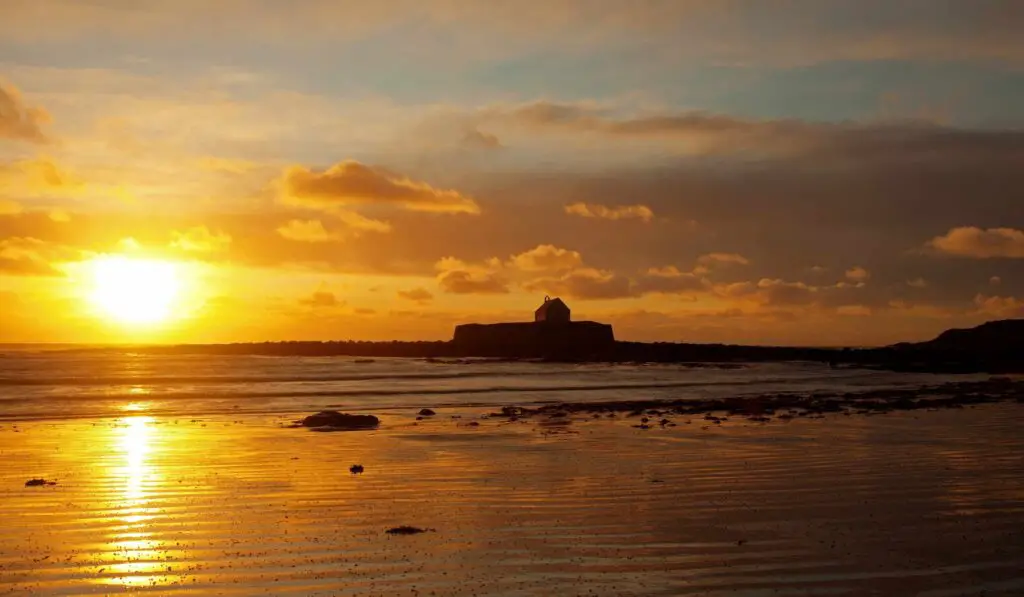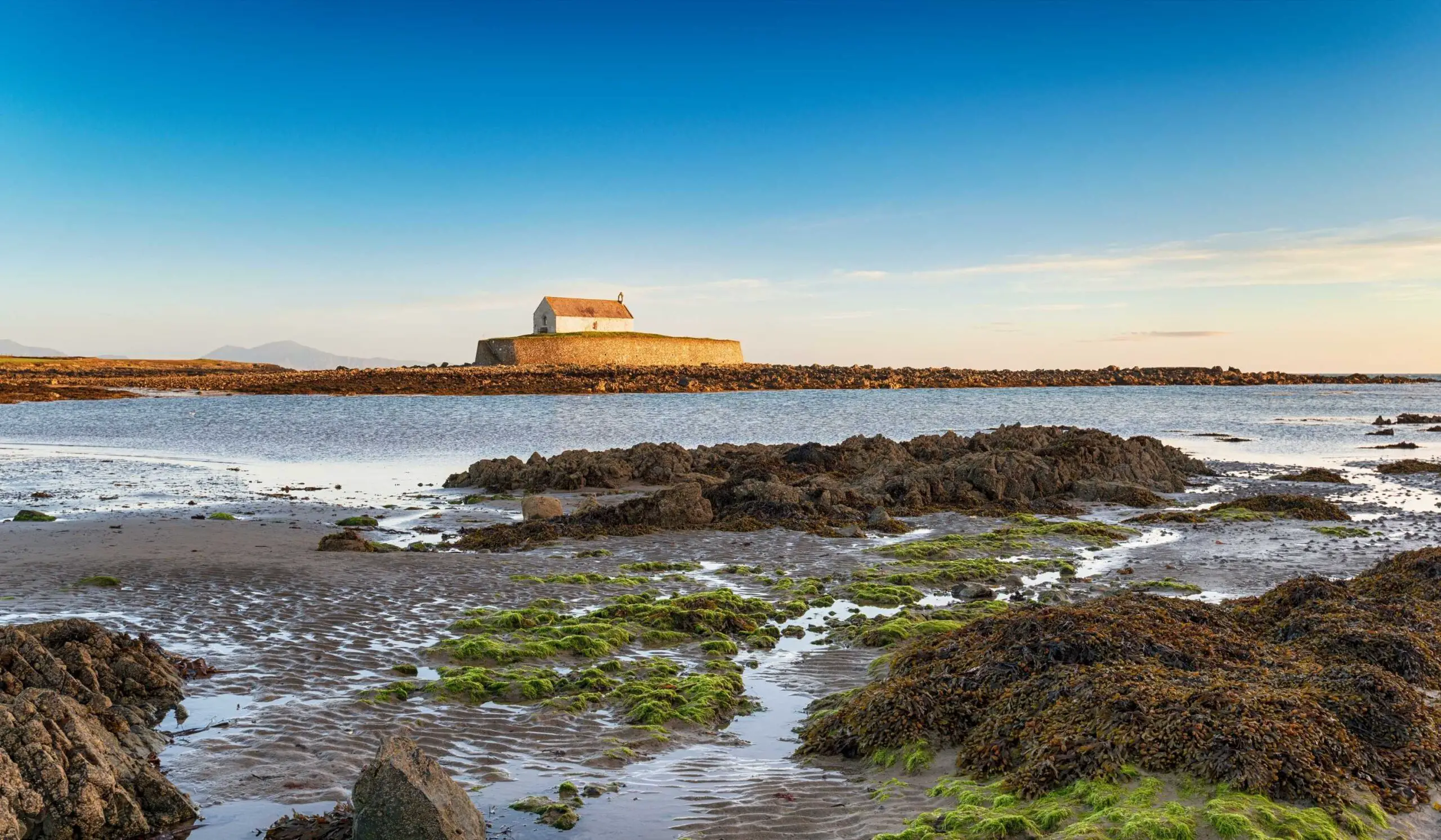St Cwyfan’s church (Eglwys Cwyfan), known by many as the “little church in the sea”(or Eglwys bach y môr in Welsh), is located on an island only accessible during low tide. The Grade II listed church has long been a popular hotspot for locals and visitors for centuries and is perhaps the most recognisable church in North Wales.
Nestled in a bay situated between Aberffraw and the Anglesey Circuit, the church began its life on land situated on a peninsula between Porth China and Porth Cwyfan. However, after centuries of gradual erosion, the church now sits “marooned” in a singular bay and can only be accessed during the hours of low tide.
As a result, this small tidal island (called Cribinau) has become one of the most visited sites on the Isle of Anglesey. So if you are planning on visiting this with the evocative old church, here’s what you need to know.

The Church in the Sea: A Brief History
St Cwyfan’s church dates right back to the 12th century, although it is thought there has been some form of church here from at least the 7th century onwards. It was constructed in dedication to Saint Kevin (St Cwyfan), who founded the nearby monastery over the Irish Sea in Glendalough, Ireland. Once the land had eroded to make Cribinau island, a small causeway was built so that villagers could still make it to the church.
As the waves continued to erode Cribinau, the cliff edge eroded, and graves surrounding the church began falling into the sea. At this point, the church was abandoned and replaced by a new church building located further inland at Llangwyfan.

Without a priest or active congregation, the church quickly began to fall into a state of disrepair. However, in 1893 a local architect, Harold Hughes, raised money to save the church by constructing a seawall around the Cribinau and restoring the building.
While the church’s existence has been relatively unremarkable (despite its scenic location), there was some controversy during the 18th century, when an English-speaking priest was appointed to St Cwyfan’s, as we shall now explain.
St Cwyfan’s Church Causes New Ruling Regarding Primarily Welsh Speaking Parishes
The issue surrounding the priesthood of this particular church started in 1766 when the Bishop of Bangor appointed Thomas Bowles as the parish priest of Trefdraeth, which included St Cwyfan’s church.
The problem was that only five of the 500-strong congregation spoke English, and Bowles spoke no Welsh at all. Consequently, they launched a petition to have him replaced with a Welsh-speaking priest and the case was heard in an ecclesiastical court in 1773.

The court ruled that Welsh-speaking priests should be sent to primarily Welsh-speaking parishes. However, Bowles had already been granted the ecclesiastical freehold to the parish, meaning he couldn’t be removed until his death. So Bowles stayed in post, despite the significance of the new ruling. However, villagers didn’t have to wait long as Bowles died in November 1773 and was promptly replaced by Richard Griffith, a Welsh-speaking priest.
Getting to the Church in the Sea
The best way to access the beach upon which the church is situated is via Aberffraw. If you’re driving:
Turn off the A4080 onto Llewelyn Street
Follow Llewelyn Street as it twists through Aberffraw and eventually turns into Church Street
Stay on Church Street as it narrows to a single track road and winds through farmer’s fields.
Keep going until you come to the bottom of the road, where you’ll see unofficial layby parking on your right.
If you’re on foot, you can park up in Aberffraw and take the Anglesey Coastal Path to the bay, stopping off at Cribinau on your way. Below is a circular route plotted on an OS Map, should you want to make a circular walk out of it.

St Cwyfan’s Church FAQs
How Old is St Cwyfan’s Church?
Although the church was initially built in the 12th century, only a small portion of the south wall dates from this period. Most of the walls you see today were rebuilt during a 14th-century reconstruction.
In the early 16th century, an aisle was added to the north side, accessed through an arcade of three arches, but it was demolished in the early 19th century. You can actually see the infilled arches in the outer wall after workers removed the old cement mortar during a refurbishment in 2006. The walls were also limewashed during this renovation, giving the church its current white colour (it used to be grey).
Can You Get Married at St Cwyfan’s Church?
Yes, you can! The church is still in service and hosts many weddings and baptisms each year.
Can You Go Inside St Cwyfan’s Church?
The church is locked most of the time. However, you can go inside if attending one of the ceremonies mentioned above or other similar church services. You can, however, peer in through the exterior windows and see the church’s interior should you wish.
Do I Need to Check the Tide Times Before Accessing St Cwfan’s Church?
It may sound obvious, but yes. The church is only accessible during the hours of low tide. The last thing you want to do is get stranded, so make sure you are aware of the tide times before setting off.
Are There Any Facilities at St Cwyfan’s Church?
There are minimal facilities at the entrance to Porth Cwyfan. There is limited parking for 10-15 vehicles, a few bench seats, and a bin. There are no toilets or other facilities to speak of.
What’s the Postcode for the Church in the Sea?
The closest postcode for this site is LL63 5PJ. However, you will need to continue down Church Street until you reach the end of the road.
How Easy is it to Walk to St Cwyfan’s Church?
The walk from the car park is relatively straightforward from the grass verge parking. However, once you leave the beach and begin to walk on the causeway, please note that it is very rocky and uneven. It may not suit those unstable on their feet or with accessibility requirements.
In total, the walk to the church from the car park should take no more than 15 minutes, with the return journey likely to take a similar amount of time.

